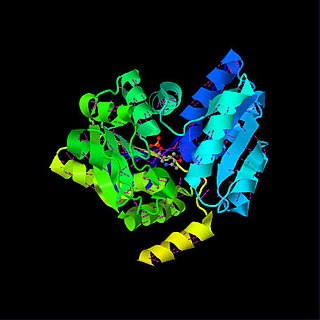Related Research Articles

Tryptase is the most abundant secretory granule-derived serine proteinase contained in mast cells and has been used as a marker for mast cell activation. Club cells contain tryptase, which is believed to be responsible for cleaving the hemagglutinin surface protein of influenza A virus, thereby activating it and causing the symptoms of flu.
Renal tissue kallikrein is an enzyme.
Clostripain is a proteinase that cleaves proteins on the carboxyl peptide bond of arginine. It was isolated from Clostridium histolyticum. The isoelectric point of the enzyme is 4.8-4.9, and optimum pH is 7.4~7.8. The composition of the enzyme is indicated to be of two chains of relative molecular mass 45,000 and 12,500.

Cathepsin G is a protein that in humans is encoded by the CTSG gene. It is one of the three serine proteases of the chymotrypsin family that are stored in the azurophil granules, and also a member of the peptidase S1 protein family. Cathepsin G plays an important role in eliminating intracellular pathogens and breaking down tissues at inflammatory sites, as well as in anti-inflammatory response.

Actinidain is a type of cysteine protease enzyme found in fruits including kiwifruit, pineapple, mango, banana, figs, and papaya. This enzyme is part of the peptidase C1 family of papain-like proteases.

Serine dehydratase or L-serine ammonia lyase (SDH) is in the β-family of pyridoxal phosphate-dependent (PLP) enzymes. SDH is found widely in nature, but its structure and properties vary among species. SDH is found in yeast, bacteria, and the cytoplasm of mammalian hepatocytes. SDH catalyzes the deamination of L-serine to yield pyruvate, with the release of ammonia.
In enzymology, a thiol S-methyltransferase is an enzyme that catalyzes the chemical reaction

In enzymology, an (S)-2-hydroxy-acid oxidase (EC 1.1.3.15) is an enzyme that catalyzes the chemical reaction
Palmitoyl-CoA hydrolase (EC 3.1.2.2) is an enzyme in the family of hydrolases that specifically acts on thioester bonds. It catalyzes the hydrolysis of long chain fatty acyl thioesters of acyl carrier protein or coenzyme A to form free fatty acid and the corresponding thiol:

Cathepsin L1 is a protein that in humans is encoded by the CTSL1 gene. The protein is a cysteine cathepsin, a lysosomal cysteine protease that plays a major role in intracellular protein catabolism.

Cathepsin E is an enzyme that in humans is encoded by the CTSE gene. The enzyme is also known as slow-moving proteinase, erythrocyte membrane aspartic proteinase, SMP, EMAP, non-pepsin proteinase, cathepsin D-like acid proteinase, cathepsin E-like acid proteinase, cathepsin D-type proteinase) is an enzyme.

Cathepsin L2 is a protein encoded in humans by the CTSV gene.

Gamma-glutamyltransferase 1 (GGT1), also known as CD224, is a human gene.
Cathepsin X is an enzyme. This enzyme catalyses the following chemical reaction
Endopeptidase So is an enzyme. This enzyme catalyses the following chemical reaction
Glycyl endopeptidase is an enzyme. This enzyme catalyses the following chemical reaction
Caricain is an enzyme. This enzyme catalyses the following chemical reaction: Hydrolysis of proteins with broad specificity for peptide bonds, similar to those of papain and chymopapain
Histolysin is an enzyme. This enzyme catalyses the following chemical reaction
Candidapepsin is an enzyme. This enzyme catalyses the following chemical reaction
Signal peptidase II is an enzyme.
References
- ↑ Gohda E, Pitot HC (May 1981). "Purification and characterization of a new thiol proteinase from rat kidney". Biochimica et Biophysica Acta (BBA) - Enzymology. 659 (1): 114–22. doi:10.1016/0005-2744(81)90275-8. PMID 7248311.
- ↑ Gohda E, Pitot HC (March 1981). "A new thiol proteinase from rat liver". The Journal of Biological Chemistry. 256 (5): 2567–72. doi: 10.1016/S0021-9258(19)69820-0 . PMID 6780567.
- ↑ Pitot HC, Gohda E (1987). "Cathepsin T". Metabolism of Aromatic Amino Acids and Amines. Methods in Enzymology. Vol. 142. pp. 279–89. doi:10.1016/s0076-6879(87)42038-7. ISBN 978-0-12-182042-8. PMID 2885716.